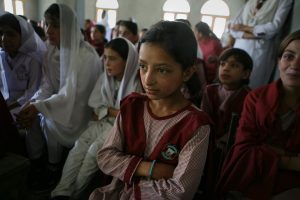GIRLS' EDUCATION
Pakistan stands out as a nation with significant difficulty in achieving gender equality in education. Approximately 22.5 million children in Pakistan, the vast majority of whom are girls, do not attend school. Girls are more likely to drop out of school than boys their age (32% vs 21%). By the end of sixth grade, 59% of girls, compared to 49% of boys, drop out of school. This disparity between the sexes continues throughout middle school, with just 13% of girls enrolled in high school by the end of ninth grade.
Girls in many parts of Pakistan attend elementary and middle school but are prevented from continuing their education due to a lack of high schools in their communities. National Education Policy Framework 2018 data shows that girls have greater educational and economic disadvantages than boys at every level, with over 2 million more girls not in school and fewer girls enrolled in grades 6 through 12, than boys.
In February 2014, the Government of Pakistan and UNESCO signed the Malala Funds-in-Trust agreement to create the comprehensive initiative “Support to national capacity building to realize girls’ right to education in Pakistan.” Since July 2015, the program has been rolled out in selected districts across nine provinces and areas (Balochistan, Khyber Pakhtunkhwa, Punjab, and Sindh) and four federal areas (Pakistan Administered Kashmir, Federally Administered Tribal Areas – FATA, Gilgit-Baltistan, and the Islamabad Capital Territory).
Article 25-A of the Constitution of Pakistan mandates free and compulsory basic education for all children, including boys and girls between the ages of 5 and 16. It is just one of Pakistan’s initiatives to codify its commitment to improving the education sector.
CREDP envisions that every girl living in a rural or urban area should have access to quality education, regardless of where she lives in Pakistan. Gender inequality in Pakistan must be addressed head-on by eliminating the delay in achieving educational parity. The government’s policies and legislation concerning girls’ education also have significant gaps. There is little emphasis placed on the problem of unequal access to education for females in the current National Education Policy Framework (2018). Any specific legislation or policy does not guarantee equal educational opportunities for all girls in the nation; proper implementation is a must. Given that girls’ access to education is crucial to any nation’s development and is a fundamental right of all Pakistani women, the country’s education ministry must give this issue its full attention.
LATEST
UPDATES

Empowering Pakistan’s Future: The Importance of Girls’ Education
Despite some progress, Pakistan still faces significant challenges in ensuring equal access to quality education for girls.
LATEST PUBLICATIONS

Empowering Pakistan’s Future: The Importance of Girls’ Education
Despite some progress, Pakistan still faces significant challenges in ensuring equal access to quality education for girls.
LATEST PUBLICATIONS

Girls’ Education in Pakistan: A Critical Challenge
In Pakistan, girls are more likely to drop out of school.